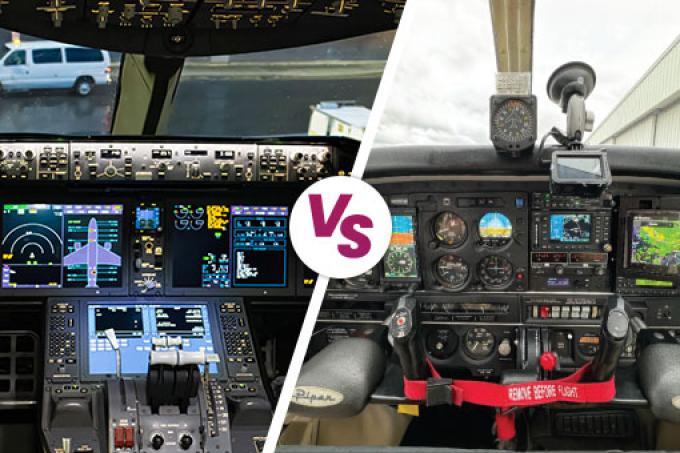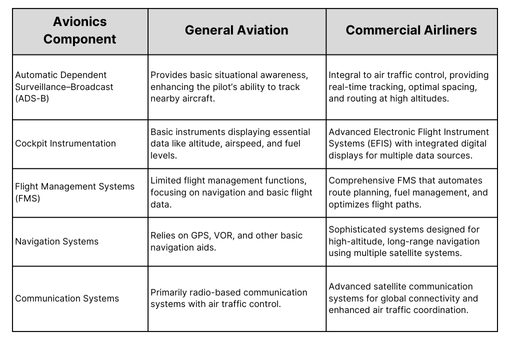
Avionics are electronic systems designed for use in aircraft, enabling essential functions like navigation, communication, and flight management. For general aviation, avionics often focus on basic safety and functionality, while airliners require advanced systems to handle complex operations, air traffic control, and international navigation. With rapid advancements, avionics systems have become integral not only to enhancing flight capabilities but also to ensuring the safety and efficiency of every flight.
Aviation electronics, or avionics, play a critical role in ensuring safe and accurate flights. The primary avionics components in an aircraft include cockpit instrumentation and flight management systems (FMS). These components vary significantly between general aviation aircraft and airliners.
In general aviation, cockpit instrumentation is straightforward, often focusing on basic data like speed, altitude, and fuel status. Commercial airliners, however, employ complex flight management systems to automate and optimize flight paths, reduce pilot workload, and improve operational efficiency. Advanced electronic flight instrument systems (EFIS) are standard in most airliners, providing digital displays that integrate multiple readings, enabling pilots to respond swiftly to any potential issues.
Read More: Aircraft Engines Battle: Piston vs TurboProp vs TurboFan
Reliable navigation is essential in both types of aviation, but the systems in use vary widely. General aviation often relies on GPS and VOR, while airliners employ advanced navigation systems to handle long-range travel, as well as communication systems like satellite-based communication to maintain clear contact with air traffic control, even at high altitudes or remote locations.
Avionics play an indispensable role in training pilots for both general aviation and commercial flight. Understanding cockpit instrumentation, navigation, and flight management systems is critical for mastering flight controls, handling emergency situations, and learning air traffic control protocol.
For student pilots, EFIS provides a visual and data-rich learning environment, helping them better understand altitude, heading, and other vital readings on a single digital display. Pilots in training can experience real-time simulations of various scenarios, helping them learn to navigate using avionics and respond effectively to emergencies.
Emergency situations call for quick, effective responses. Avionics training helps pilots develop a solid grasp of emergency navigation systems and protocols. The role of avionics in these situations is particularly emphasized for airliners, where safety protocols are more complex due to the larger scale and number of passengers.
The avionics technology used in general aviation and airliners differs significantly in complexity and functionality, tailored to each sector's unique demands. General aviation, encompassing smaller aircraft, often requires simpler avionics focused on essential flight operations. Meanwhile, commercial airliners rely on advanced avionics to manage long-haul flights, high-altitude navigation, and complex air traffic control requirements. This comparison table highlights the key differences in avionics systems, including Automatic Dependent Surveillance-Broadcast (ADS-B), flight management, and navigation systems.

Avionics Component (Source Image: 14DAYPILOT)
The evolution of avionics continues to accelerate, with upgrades and new technologies aiming to enhance safety, efficiency, and sustainability across the aviation industry.
With the continuous need for optimization, many aircraft undergo avionics upgrades to integrate the latest technology. These upgrades can include enhanced air traffic control avionics and EFIS updates, equipping aircraft with cutting-edge technology that meets the latest standards.
Avionics technology is poised for significant advancement, especially with the integration of AI, which can optimize flight management and improve predictive maintenance. Additionally, newer automatic navigation systems are expected to support more autonomous operations, promising a future where avionics could further enhance safety and reduce operational costs for both small planes and airliners.
Read More: How to Choose the Best Flight School For You?
Mastering the intricacies of avionics is crucial for every aspiring pilot. Our program dives into essential components, from cockpit instrumentation to advanced navigation systems, highlighting how these systems enhance flight safety, efficiency, and communication. With rapid advancements in technology, staying current is vital. Join us for a 10 Day Accelerated Instrument Rating Program at 14DAYPILOT, where you’ll gain in-depth knowledge and hands-on experience in avionics, setting you on the path to becoming a proficient and confident pilot!

Avionics systems form the technological backbone of modern aviation, influencing everything from navigation to safety and communication. Although both general aviation and airliners rely heavily on avionics, the depth and complexity of these systems vary significantly. This article explores the primary aspects of avionics, such as cockpit instrumentation, flight management, and navigation systems, comparing their applications and roles in general aviation versus commercial airliners
Avionics are electronic systems designed for use in aircraft, enabling essential functions like navigation, communication, and flight management. For general aviation, avionics often focus on basic safety and functionality, while airliners require advanced systems to handle complex operations, air traffic control, and international navigation. With rapid advancements, avionics systems have become integral not only to enhancing flight capabilities but also to ensuring the safety and efficiency of every flight.
Aviation electronics, or avionics, play a critical role in ensuring safe and accurate flights. The primary avionics components in an aircraft include cockpit instrumentation and flight management systems (FMS). These components vary significantly between general aviation aircraft and airliners.
In general aviation, cockpit instrumentation is straightforward, often focusing on basic data like speed, altitude, and fuel status. Commercial airliners, however, employ complex flight management systems to automate and optimize flight paths, reduce pilot workload, and improve operational efficiency. Advanced electronic flight instrument systems (EFIS) are standard in most airliners, providing digital displays that integrate multiple readings, enabling pilots to respond swiftly to any potential issues.
Read More: Aircraft Engines Battle: Piston vs TurboProp vs TurboFan
Reliable navigation is essential in both types of aviation, but the systems in use vary widely. General aviation often relies on GPS and VOR, while airliners employ advanced navigation systems to handle long-range travel, as well as communication systems like satellite-based communication to maintain clear contact with air traffic control, even at high altitudes or remote locations.
Avionics play an indispensable role in training pilots for both general aviation and commercial flight. Understanding cockpit instrumentation, navigation, and flight management systems is critical for mastering flight controls, handling emergency situations, and learning air traffic control protocol.
For student pilots, EFIS provides a visual and data-rich learning environment, helping them better understand altitude, heading, and other vital readings on a single digital display. Pilots in training can experience real-time simulations of various scenarios, helping them learn to navigate using avionics and respond effectively to emergencies.
Emergency situations call for quick, effective responses. Avionics training helps pilots develop a solid grasp of emergency navigation systems and protocols. The role of avionics in these situations is particularly emphasized for airliners, where safety protocols are more complex due to the larger scale and number of passengers.
The avionics technology used in general aviation and airliners differs significantly in complexity and functionality, tailored to each sector's unique demands. General aviation, encompassing smaller aircraft, often requires simpler avionics focused on essential flight operations. Meanwhile, commercial airliners rely on advanced avionics to manage long-haul flights, high-altitude navigation, and complex air traffic control requirements. This comparison table highlights the key differences in avionics systems, including Automatic Dependent Surveillance-Broadcast (ADS-B), flight management, and navigation systems.

Avionics Component (Source Image: 14DAYPILOT)
The evolution of avionics continues to accelerate, with upgrades and new technologies aiming to enhance safety, efficiency, and sustainability across the aviation industry.
With the continuous need for optimization, many aircraft undergo avionics upgrades to integrate the latest technology. These upgrades can include enhanced air traffic control avionics and EFIS updates, equipping aircraft with cutting-edge technology that meets the latest standards.
Avionics technology is poised for significant advancement, especially with the integration of AI, which can optimize flight management and improve predictive maintenance. Additionally, newer automatic navigation systems are expected to support more autonomous operations, promising a future where avionics could further enhance safety and reduce operational costs for both small planes and airliners.
Read More: How to Choose the Best Flight School For You?
Mastering the intricacies of avionics is crucial for every aspiring pilot. Our program dives into essential components, from cockpit instrumentation to advanced navigation systems, highlighting how these systems enhance flight safety, efficiency, and communication. With rapid advancements in technology, staying current is vital. Join us for a 10 Day Accelerated Instrument Rating Program at 14DAYPILOT, where you’ll gain in-depth knowledge and hands-on experience in avionics, setting you on the path to becoming a proficient and confident pilot!
Ilham Febrian is a dedicated aviation blogger with a strong interest and high expectations for the aviation industry. He holds a DGCA Commercial Pilot license with Airbus A320 type rating. Continuously updated with the latest aviation news, Ilham strives to provide top-quality content on the website, aimed at assisting all pilots. The website focuses on offering flight training guidance, information on flying school materials, and tips on how students can successfully pass their check rides.
Ilham Febrian is a dedicated aviation blogger with a strong interest and high expectations for the aviation industry. He holds a DGCA Commercial Pilot license with Airbus A320 type rating. Continuously updated with the latest aviation news, Ilham strives to provide top-quality content on the website, aimed at assisting all pilots. The website focuses on offering flight training guidance, information on flying school materials, and tips on how students can successfully pass their check rides.